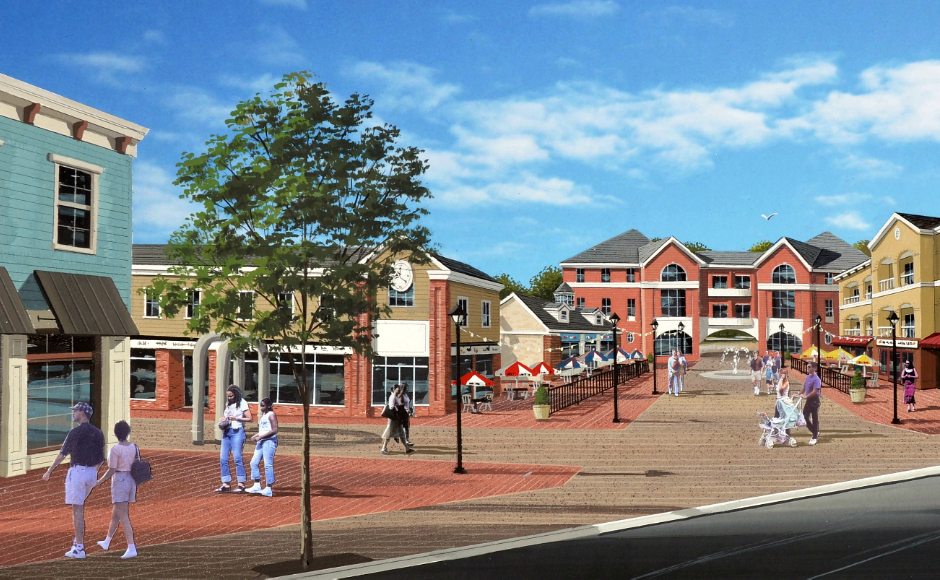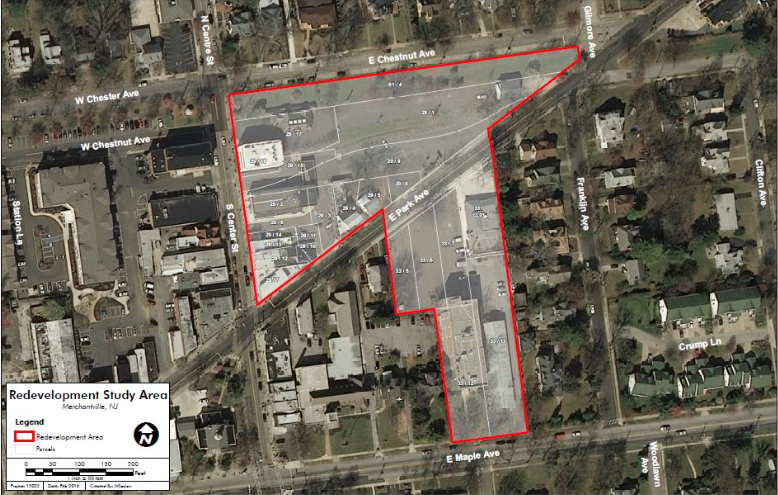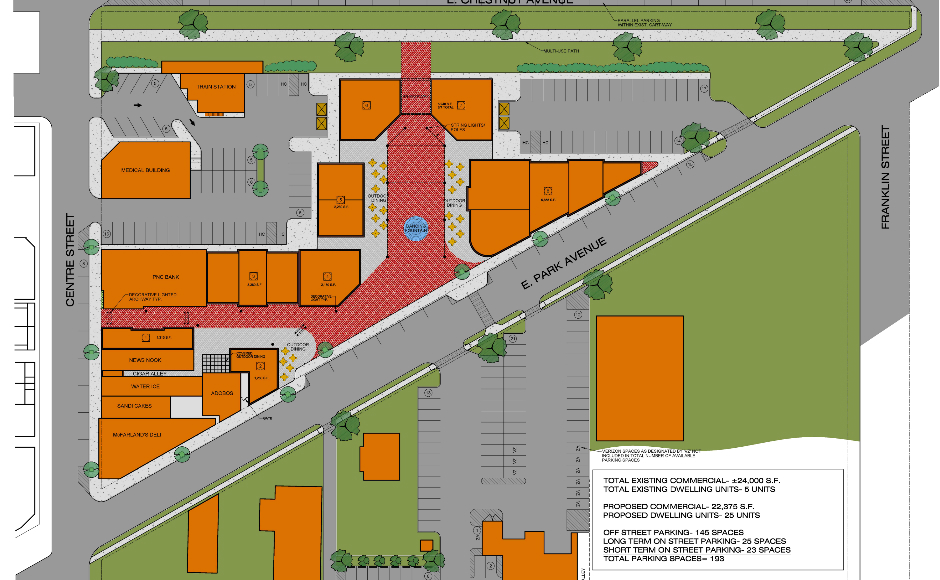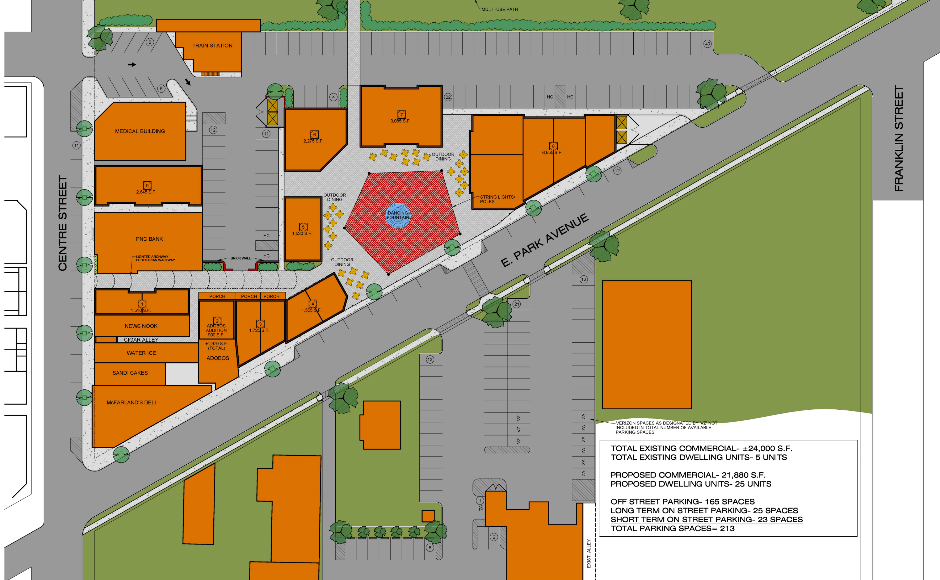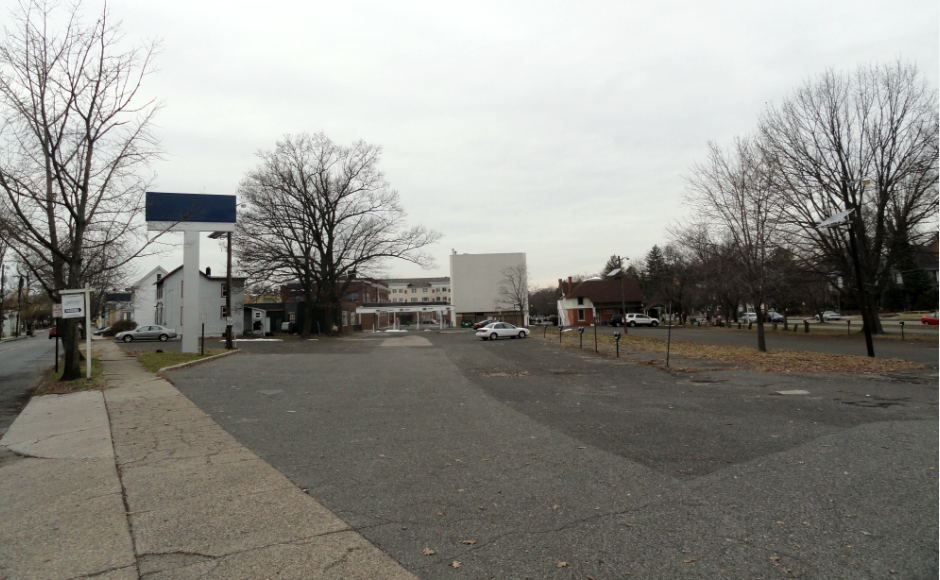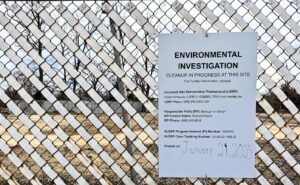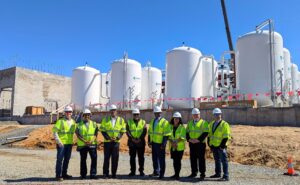A pair of alternative designs for the 2-acre triangular lot in the borough downtown will head to the local planning board for review May 10.
By Matt Skoufalos
The triangular, 2-acre lot at the center of downtown Merchantville has been a “dead zone” for years. Bordered by Park and Chestnut Avenues and Centre Street, it has twice been the object of redevelopment plans that fizzled since the late 1990’s, and was formally acquired by the borough for less than $1 million in 2008.
Over the past year, however, a group of residents working with local leaders and a planner from Ragan Design Group of Medford has completed a pair of redevelopment concepts for the site that Mayor Ted Brennan hopes will be the proverbial third time lucky.
“I think the real value here is in re-igniting our downtown business district,” Brennan said. “Being a small community, it’s difficult to raise additional revenues. Our taxes are being collected at a fantastic clip, but we also have this vacant land that’s been sitting here for 10 years.
“We need to be smart about the way we redevelop so we can ensure there’s a steady stream of revenue that comes from this land,” he said.
Two site concepts will be reviewed by the Merchantville Planning Board May 10: one that creates pedestrian streets that square off the triangular edges of the site, and another that places a piazza at its center. Both plans focus heavily on walkability, access, and creating a public gathering space; both plans restrict first-floor use to retail, and both are zoned for outdoor dining. Brennan envisions either site as being able to cultivate a public arts scene around the central space, which could be accented by a water feature.
The pedestrian street concept would connect the redevelopment site to Centre Street as well as to the local bike trail off Chestnut Avenue; the piazza concept rings a central gazebo or amphitheater, and is heavier on parking.
In both scenarios, the borough gains anywhere from 193 to 213 public parking spaces, many of them via an agreement with Verizon for use of its parking lot off Park Avenue, which would be milled over, laned, and re-striped as a public parking lot shared among the phone company, the borough, and the local fire department.
Both concepts add 22,000 square-feet of commercial space and about 25 condos or apartments in approximately three-story buildings. In appearance, the site would retain architectural characteristics of the surrounding neighborhoods, paying homage to its history while meeting contemporary design standards, Brennan said.
“We want to market this to anyone who wants to live in town, and at the same time, market this to young families who are interested in a quasi-urban feel in a small, suburban community like Merchantville,” he said. “How do we create enough critical mass in this area? The concepts have really shown that you can do that.”
Certain aspects of the site will remain tougher than others to resolve, and multiple developers may be required to complete different phases, Brennan said. The former PNC bank building could be a particularly tough sell, he said; the town is exploring options for its creative reuse.
“If one developer wants to come in and meet the majority of our vision, I’m not opposed to that,” Brennan said.
“I know it’s a difficult site to redevelop. That’s why it’s our third time trying to do this. Market forces may require them to ask for certain things, and we may be interested in certain things. I want to go through appropriate due diligence to see who’s willing to meet the vision of this group.”

Sample elements that will appear in the Merchantville redevelopment design concept. Credit Ragan Group.
‘It’s a feel-good project’
Planner Mara Wuebker of Ragan Design Group said that transparency was a priority throughout the process of drafting the concepts, in the form of public workshops, a Facebook group, and frequent updates.
Design alternatives were shaped with the input of various members of the community, including business owners, residents, and local professionals.
“We started out with a couple different alternatives that were generated from committee,” she said. “People were sketching up what they’d like to see the area look like.”
Developing for a triangular site is “tricky,” but both designs create linkages to the existing bike path as well as the nearby parking lot, Wuebker said. Parking was voiced frequently as a concern of residents, and designers worked to balance the square-footage of the project footprint against “wanting to keep the character and the quaintness of the town,” she said.
“It’s not urban, it’s not suburban; it’s somewhere in the middle,” Wuebker said. “Additionally, what comes with this is a signage campaign. There is a lot of parking, and sometimes people don’t know where it is.”
The design that emerged from the redevelopment process is consistent with the style of the existing Merchantville downtown in terms of construction materials and density, Wuebker said. By prioritizing pedestrian accessibility and creating “a unique space that would be magnetic,” the redevelopment can improve foot traffic for existing businesses as well as creating new business opportunities with an infusion of residents, she said.
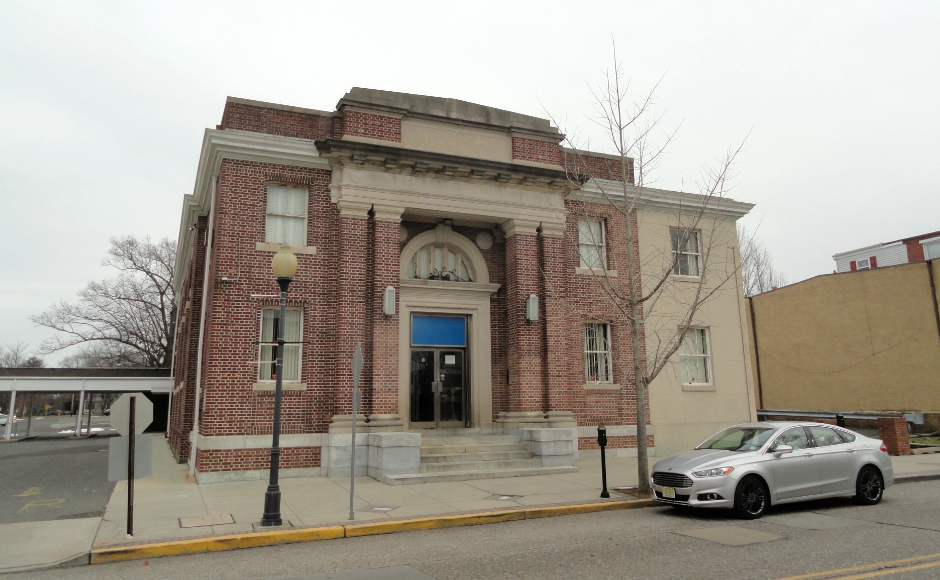
The former PNC Bank Merchantville could be a challenge to redevelop, Mayor Ted Brennan said. Credit: Matt Skoufalos.
“The idea is that they would piggyback onto each other,” Wuebker said. “People who are going to come to the pedestrian street area are going to pick up their eggs and milk at the convenience store. There will be overflow to the adjacent businesses on Centre Street and Park Avenue.”
Wuebker expects the site to help revive interest in the local economy. She said organizers view it as a continuation of the things that lend the borough its small-town charm.
“Merchantville is easy to love,” she said. “You just want to do everything you can to make sure that it continues to be a great and viable community. It’s a feel-good project.”
Councilwoman Katherine Swann, who operates a pair of businesses in the borough (duck duck goose toy store and The Station café and arts center) said Merchantville’s virtues and its struggles are tied together.
“It’s this tiny little place that nobody knows about,” Swann said. “We’re able to keep our little neighborhood, but it’s a struggle to attract businesses because the town isn’t able to sustain itself. We need more businesses to attract more customers, but you need more customers to attract more businesses.”
Swann said the redevelopment most excites her for its chance to create a public commons for special events. Having such a site would limit the need for street closures while also connecting the new town square with the heavily used bike path that intersects Centre Street.
“[The multi-use path is] almost like our main street,” Swann said. “It’s nice that this development’s right there, and I hope that it will pull people in.”
The project could break ground in late 2017 or early 2018 at the earliest; in the next few months, however, the borough will knock down three abandoned properties within the redevelopment zone, all of which are “in terrible condition,” Brennan said.
Merchantville has already gone to bid for their demolition, the cost of which has already been included in the redevelopment budget.
“We really want to clean that up and show people progress,” the mayor said.

